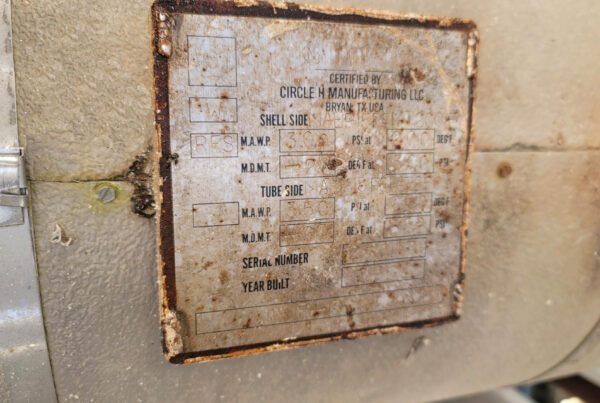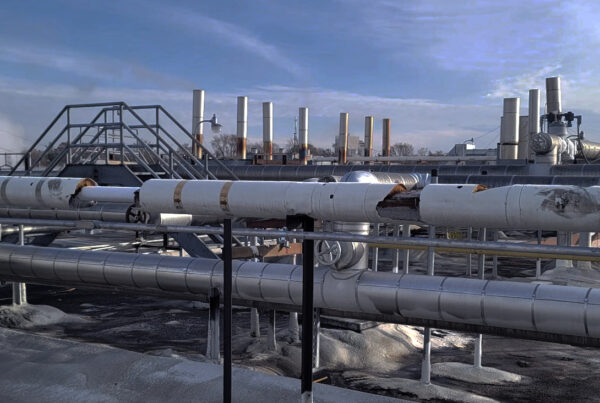10 Focused Facts to Help Your Team Level-Set
NDT Compliance Requirements for Covered Process (NH3) Systems
Guidelines that govern testing for covered process systems can be obscure. Decisions related to non-destructive testing (NDT) of piping and vessels, which do not come with manufacturer’s recommendations, can be particularly intimidating as they are to be tested to ‘conform with good engineering practices.’
This affords flexibility for you as a system owner to define your methods, thresholds, frequency, and subsequent actions. Therefore, acceptable practices in this realm exist on a spectrum. Testing activities in system owners’ plans, which range from highly conservative to non-existent, are a response to historical releases or non-compliance issues, knowledge (or lack thereof), culture, and budget. It is important to note, though – a plan that is too relaxed will leave you vulnerable to consequences.
Lack of concrete direction, compounded with general concerns around safety and increased fines associated with non-compliance, make the choice to button-up or improve your mechanical integrity compliance plan very compelling. However, this is not necessarily the most urgent priority in your day-to-day responsibilities.
To help answer the ‘how, when, and where do we test’ questions we get so often from our customers, we have consolidated the fundamentals of NDT compliance requirements on covered process (NH3) systems across all governing programs. These ten focused facts are designed to clarify the regulations and industry best practices so you and your team can determine if and how you need to make changes to your plan.
1. Regulating Bodies and Documents
If you are already familiar with the regulating bodies, jump to fact #2.
There are a lot of moving parts related to the governance of covered process systems, of which testing is just a tiny part. Let’s break it down:

The Law
The Clean Air Act is a federal law that regulates air emissions. The applicable Section 112(r) covers Accidental Release Prevention. Clean Air Act Summary
The Clean Air Act Amendments (CAAA) were enacted into law (November 15, 1990). Section 304 of the CAAA requires that the Secretary of Labor, in coordination with the Administrator of the Environmental Protection Agency (EPA), promulgate, pursuant to the Occupational Safety and Health Act of 1970, a chemical process safety standard to prevent accidental releases of chemicals that could pose a threat to employees.
The CAAA requires that the standard include a list of highly hazardous chemicals which includes toxic, flammable, highly reactive, and explosive substances. The CAAA also specified minimum elements that the OSHA standard must require employers to do, including:
(11) Establish maintenance systems for critical process-related equipment, including written procedures, employee training, appropriate inspections, and testing of such equipment to ensure ongoing mechanical integrity
The Rules
In 1992, OSHA enacted the Process Safety Management (PSM) of Highly Hazardous Chemicals Standard in response. This standard applies to those companies that deal with any of more than 130 specific toxic and reactive chemicals in listed quantities; it also includes flammable liquids and gases in quantities of 10,000 pounds (4,535.9 Kg) or more. OSHA PSM Standard; OSHA PSM Booklet Refer to 29 CFR 1910.119(j)(4) for testing language.
OSHA’s General Duty Clause, which states employers have the responsibility to provide a safe and healthful workplace that is free from serious recognized hazards, applies to all companies operating covered process systems whether they meet the threshold criteria above or are below the limits.
The EPA requires covered facilities to submit a Risk Management Plan (RMP) that describes its hazards and prevention activities, indicates its compliance with the regulations, includes analyses of offsite consequences of accidental chemical releases, a five-year accident history, a prevention program, and an emergency response program. EPA adopted the OSHA PSM standard as its prevention program for processes in Program [Level] 3. EPA RMP Rule 40 CFR part 68
The Code
IIAR published the ANSI / IIAR 6-2019 Standard for the Inspection, Testing, and Maintenance of Closed-Circuit Ammonia Refrigeration Systems.
Approved by ANSI April 26, 2019, the IIAR 6-2019 standard is now adopted to code. ANSI establishes the rules for standards development, and approves standards written by accredited organizations for industry and community adoption in the US and abroad. ANSI / IIAR 6-2019 Standard (for purchase)
2. Liability
These regulatory requirements state their collective purpose – to prevent or minimize the consequences of catastrophic releases of toxic, reactive, flammable, or explosive chemicals. However, they all define minimum standards only, and do not make any warranties or representation and do not assume liability or responsibility.
“IIAR-6 offers a baseline for this [reduce the probability of an ammonia release] and what is needed and how often it’s needed…specifies the minimum requirements for Inspection, Testing, and Maintenance tasks, which is ITM tasks, and that’s the key…”, Tony Lundell, IIAR senior director of standards and safety, in An Introduction to ANSI/IIAR 6-2019 Standard.
The liability is yours, the owner, and the goal is to develop and execute a plan that demonstrates your best efforts to mitigate release with the resources available to the industry-at-large.
3. Responsibility & Acceptance
It is the duty of the system owner to ensure the standards are followed and incorporated as part of their Mechanical Integrity (MI) program as RAGAGEP.
An owner shall be in compliance with IIAR 6-2019 when it is adopted by the (local) authority having jurisdiction (AHJ) or when it is adopted by the owner, whichever is first. The expectation for companies to comply with PSM and RMP rules went into effect in May of 1997.
4. Definition of Testing
Testing is a procedure that commonly employs calibrated instruments, devices, and/or gauges to determine the operational status of equipment, a component, or a device in the refrigeration system. Testing is not to be confused or interchanged with inspection, which is the evaluation and assessment of equipment, a component, a system, or a portion of a system using human senses such as vision, hearing, touch, smell, or a combination thereof.
5. Application of Non-Destructive Testing
OSHA believes it is important to maintain the mechanical integrity of critical process equipment to ensure it is designed and installed correctly and operates properly. PSM mechanical integrity requirements apply to the following equipment:
- Pressure vessels and storage tanks
- Piping systems (including piping components such as valves)
Non-destructive testing (NDT) is the approach that satisfies the testing requirement for piping and vessels, which do not have specific manufacturers’ instructions or procedures for testing. Employing NDT techniques to assess the current state of material allows its user to determine the fitness of product, infrastructure, and more without jeopardizing the integrity of assets in-operation.
NDT will most often be performed by a third-party NDT contractor.
6. Record Keeping
Each test on process equipment must be documented, identifying:
- the date of the test
- the name of the person who performed the test
- the serial number or other identifier of the equipment on which the test was performed
- a description of the test performed
- the results of the test
7. Testing Procedures – The Minimum Requirements
Method
Across the PSM standard, the RMP rule and IIAR-6, guidelines for how to test are:
- Testing must be performed on process equipment, using procedures that follow recognized and generally accepted good engineering practices (RAGAGEP).
- The owner or owner’s designated representative shall ensure an inspection, testing, and maintenance program is developed to reduce the probability of an ammonia release. This program shall comply with manufacturer recommendations, equipment and system operating and maintenance history, and the minimum safe requirements of this standard.
NDT, in varying degrees, can detect internal and/or external imperfections, measure properties and imperfections and identify structure and composition properties of a material. The numerous methods available offer a range of pros and cons related to efficiency, accessibility, thoroughness, accuracy, safety, and risk of asset compromise. It is necessary to appropriately vet the methods available to the industry.
For the specific areas tested, the results must provide measurements and information that allow you to validate fitness for service or determine necessary corrective actions.
Frequency
Across the PSM standard, the RMP rule and IIAR-6, guidelines for when to test are:
- The frequency of testing shall be consistent with applicable manufacturers’ recommendations and operating history.
- The frequency of inspections and tests of process equipment must conform with manufacturers’ recommendations and good engineering practices, or more frequently if determined to be necessary by prior operating experience.
- Test frequencies shall be in accordance with manufacturers’ recommendations, historical ITM data, predictive maintenance reports, and other adopted RAGAGEP.
WA (Where Applicable) – A (Annual): Testing will be performed as needed at specific locations identified as a result of a visual inspection performed during the annual Mechanical Integrity audit.
Locations
IIAR-6 defines locations to be tested where visual indications of degradation exist on piping and vessels, as follows:
Vessels:
- Where pitting or surface damage was visually observed
- Where pitting, surface damage, general corrosion, or a combination thereof, is suspected to have materially reduced the vessel wall thickness
Piping:
- Where pitting or surface damage was visually observed
- Where visual inspection indicates degradation of the insulation
- Where pitting, surface damage, general corrosion, or a combination thereof, has materially reduced the remaining pipe wall thickness
8. Testing Procedures – Best Practices
Best practices for testing covered process systems are driven by guidelines stated in PSM and RMP rules, IIAR 6-2019, the overarching requirement that an owner needs “to know the condition of their system”, and general liability.
This approach is generally more conservative and based on the philosophy that not all pipe and vessel degradation can be detected visually. It results in a plan that covers more ground and errs on the side of caution.
Method
NDT technology is chosen based on value (not cost) and tends to be more efficient, thorough, and process conscious.
Frequency
In line with IIAR 6-2019, piping and vessels are tested outside of or within the framework of a specified frequency, as follows:
- At minimal timeframe intervals independent of visual inspection at common failure points
‘Minimal timeframe intervals’ is satisfied with baseline testing across the system at common failure points (well-known vulnerable areas) and areas identified as suspect by a visual inspection. In this scenario, all piping and vessels are tested once every five years to coincide with the PSM cycle.
The exception to this rule applies to pressure vessels that are not at least ten years old and do not show any external evidence of corrosion or degradation. In this case, an engineering deferral would apply.
Locations
Vessels:
- On insulated vessels where water is most likely to infiltrate and corrode the shell or heads
- On uninsulated vessels where most corrosive activity is present
Piping:
- Where there is a visual indication of non-compliance, degradation, or non-working parts in the system
- Where visual inspection identifies a component as suspect or requiring additional investigation
- Where the condition of a component cannot be determined by visual inspection
- At common failure points (including but not limited to components, roof and wall penetrations, before and after direction changes, at valve groups, insulation terminations and end caps, and sagging areas)
9. Your Hiring Responsibilities
NDT contractors must also comply with specific guidelines stated in the PSM standard (listed below in Contractor Responsibilities) – it is your duty upon hiring to verify that they do so.
While not required, it is best practices to hire an NDT company that does not also perform your MI inspections. The same applies to hiring your maintenance or building contractor to also perform testing and/or inspections. Both scenarios invite the opportunity for conflicts of interest and do not afford for necessary checks and balances.
10. Contractor Responsibilities
The PSM standard “applies to contractors performing maintenance or repair, turnaround, major renovation, or specialty work on or adjacent to a covered process.” Therefore, NDT services providers must provide you with proof upon request that they comply with the following:
- Their employees are trained in the work practices necessary to perform their job safely
- Their employees are instructed in the known potential fire, explosion, or toxic release hazards related to their job and the process, and in the applicable provisions of the emergency action plan
- Documented assurance their employees have received and understood the training required
- Employees will follow the safety rules of the facility, including the safe work practices required in the operating procedures section of the standard
- Notification to you of any unique hazards presented by their work.



